Using the framework of firm investment, economists can understand why firms invest in particular areas. The goal of any firm is to maximize its profits. By addressing investment decisions using the framework described above, firms can avoid the pitfalls of other firms. Unfortunately, firms that do not maximize their profits will fail in the long run, and the Darwinian forces will eventually remove these poor companies from the competitive market. If you want to learn more about the motivations of firms and how to make better decisions, read on.

One important factor that influences firm investment is the level of financial leverage. As a result, firms with higher levels of leverage have less investment than those with lower levels of leverage. In addition, firms with lower financial leverage are less likely to invest in the most effective strategies. Increasing the amount of equity funds available to a firm allows a firm to achieve a higher growth rate and to grow at a faster rate. However, this type of funding isn’t always available in the form of loans or equity.
In addition to focusing on financial leverage, firms with a low level of information asymmetry are more likely to invest in the same sector as larger firms. This means that a small firm’s financial leverage will negatively affect its investment decisions. High-growth firms are less likely to have high levels of financial leverage, which makes the relationship between leverage and firm investment even weaker. The problem is that these types of financial sources cannot compensate for the lack of legal and financial systems in a developing country.
In addition, financial leverage is not correlated with firm investment. Rather, it correlates negatively with the amount of money a firm can invest. This is true for low-growth firms that lack strong information systems. Likewise, a low-growth firm with a low information asymmetry will have higher financial leverage. In contrast, a high-information asymmetric firm will have little or no leverage. Therefore, it is best to invest in a company that is able to provide growth through a combination of trade credit and equity.
In general, financial leverage is associated with the amount of money a firm can borrow. In the case of low-growth firms, this relationship is not significant. On the other hand, financial leverage is negatively related to the amount of money a firm can raise. While the ratio is not significant for high-growth firms, it is not statistically significant for low-growth companies. So, the results are still relevant. In developing countries, the presence of debt in the economy is detrimental to the growth of a firm.
A firm’s financial leverage is a key determinant of its ability to increase its value. A high information asymmetry is associated with a negative correlation with financial leverage. But if the firm is a high-growth firm, the relationship between financial leverage and a low-growth company is significant. While there are a number of variables affecting the performance of a business, the most relevant is its information asymmetry.